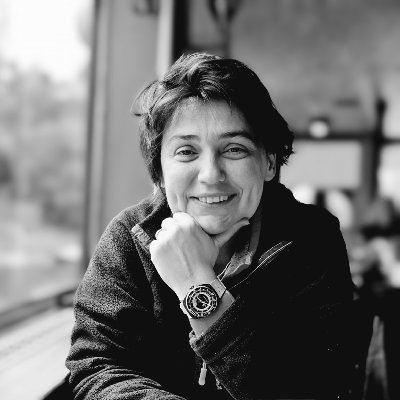
Paleoclimate Dynamics Group
@paleo_dyn
Followers
51
Following
34
Media
17
Statuses
145
We are group of scientists studying past, modern, and future climate based on different types of data (proxies, observations, models). Opinions are our own.
Joined August 2022
If we take into account the results, look how cool the AI image generator represents the climate in Antarctica at such a deep time! Check out also our press release! https://t.co/2VjRWBnU2M
0
0
1
The fundamental shift from greenhouse to icehouse climate allowed ice to grow in the East where temperature was low and precipitation high enough. The West was still too mild for an ice sheet and instead covered by cool-temperate climate vegetation.
1
0
0
Model simulations support that while already developing a large ice sheet in the East with about half of the size of today’s ice sheet (regarding sea level equivalent).
1
0
0
In this paper the authors combine model simulations and sediment core data drilled in the Amundsen Sea Embayment. From the sediment cores they found no signs of ice presence in West Antarctica during this period.
1
0
0
We are thrilled to announce the new paper from Klages et al. in collaboration with our paleodyns MSc Hanna Knahl and Drs. Lu Niu, Gerrit Lohmann and Paul Gierz, with exciting new insights into the build-up of the Antarctic Ice Sheet ~34 million years ago. https://t.co/oqDleDcKQW
science.org
One of Earth’s most fundamental climate shifts, the greenhouse-icehouse transition 34 million years ago, initiated Antarctic ice sheet buildup, influencing global climate until today. However, the...
1
0
0
Please also refer to the press release for more information:
0
0
0
Details of physical mechanisms and of the speed of ice sheet dynamics in glacial cycles remain uncertain. Niu et al. have addressed this topic at the example of the expansion of the Laurentide Ice Sheet towards the Last Glacial maximum.
1
1
1
Proud to be the supervisor of @MaQiyun . His new paper gives an insight in how bad the situation is with the summer wet-bulb temperature (WBT) in Europe. European Summer Wet-Bulb Temperature: spatiotemporal variations and potential drivers
1
1
7
Pretty cool paper by Heukamp et al. on how the Cyclones modulate the control of the North Atlantic Oscillation on transports into the Barents Sea. Also cool collaboration between oceanography and meteorology #Arctic #cyclones #seaice @AWI_Media
https://t.co/AiMnv7KZ49
0
2
12
9 days into September: • Unprecedented heavy #rainfall in #Greece • Damaging #Floods in Spain • Damaging #Floods in south China • Extreme #Floods in Las Vegas • #Heatwave in Central Europe • #Earthquake im Morocco How is your day going? Everything ok? #ClimateEmergency
0
7
13
The current #weather situation in Europe is a textbook Omega block. While central Europe will "enjoy" a #heatwave, Greece will face a #medicane with disastrous damages due to heavy rain and #floods fueled by an extremely hot #MediterraneanSea. #ClimateEmergency #heavyrain
4
60
123
We've delved into the complex relationship between large-scale sea ice-surface temperature interactions. Our findings underscore the importance of AMOC in shaping both Arctic and Antarctic sea ice. Check it out! 🧊🌡️ https://t.co/elgT9GdXLt
journals.plos.org
Due to its involvement in numerous feedbacks, sea ice plays a crucial role not only for polar climate but also at global scale. We analyse state-of-the-art observed, reconstructed, and modelled...
0
0
1
Details and interpretation of the results in light of a warming climate can be found in the publication by Guo et al. in Proceedings of the National Academy of Sciences. https://t.co/7WAuXaHytp. You may also read about the research in an AWI press release:
0
0
0
Validated models suggest that during the mid-Pliocene Warm Period near surface permafrost has been smaller by 93±3%. Models suggesting smallest reductions still simulate a relative loss by 40±15%. These results suggest a much reduced presence of permafrost in the mid-Pliocene.
1
0
0
There is some variability in results derived from individual models. Yet, those models, that have been successfully validated against proxy-data show the largest relative reduction of near surface permafrost, and their results agree very well with each other.
1
0
0
Guo et al. study the distribution of permafrost during the mid-Pliocene Warm Period based on output from the models of the Pliocene Model Intercomparison Project and reconstructions of permafrost. Results are pointing to much reduced permafrost in comparison to recent times.
1
0
0
High latitudes still host vast amounts of permafrost. This frozen ground contains huge amounts of carbon that will become mobile when temperatures reach the threshold for permafrost thaw. So, how does a warm world look like from the viewpoint of the distribution of permafrost?
1
0
0
Falls Sie Interesse am Standpunkt eines der führenden Paläoklimaforscher Deutschlands haben, dann können Sie aus dem Podcast "Zeitfragen" von Deutschlandfunk Kultur (44 Minuten) einen tieferen Einblick in Hintergründe gewinnen. https://t.co/EhNthBDwYj
deutschlandfunkkultur.de
Die"Letzten Generation" warnen vor Kipppunkten beim Klimawandel. Wissenschaftlich haltbar sind apokalyptische Ängste nicht, sagt Forscher Gerrit Lohmann.
0
0
0
Ein Interview mit Gerrit Lohmann unternimmt den Versuch einer Annäherung an die Klimawissenschaft aus der Perspektive der Gesellschaft. Was können wir über das Klima der Zukunft lernen? Was wird immer unvorhersagbar bleiben? Wie fühlt es sich an, das Klima zu erforschen?
1
0
0
Klimawissenschaft hat soziale Relevanz. Fragen zur Klimawissenschaft erfahren steigendes Interesse. Wie wird Klimaforschung gemacht? Welche Art von Informationen können wir von der Klimaforschung erwarten? Dieses Wissen der Allgemeinheit zugänglich zu machen ist nicht einfach.
1
0
0



